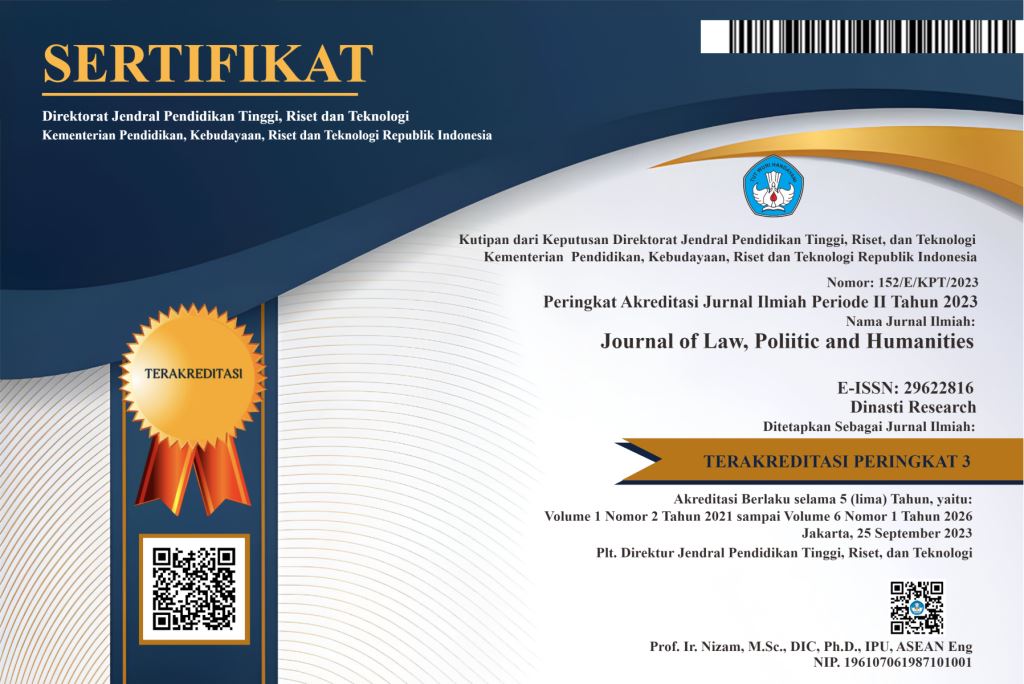The Principle of Subrogation in Motor Vehicle Loss Insurance in South Barito Regency
DOI:
https://doi.org/10.38035/jlph.v5i5.1736Keywords:
Principle of Subrogacy, Loss Insurance, Motor Vehicles, Legal Protection, South Barito RegencyAbstract
This study aims to analyze the implementation of the principle of subrogation in motor vehicle loss insurance in South Barito Regency, focusing on the challenges faced and the solutions that can be taken to ensure the effectiveness of the principle. The research uses an empirical research method by collecting data through in-depth interviews, observations, and documentation studies. The data were analyzed in a qualitative descriptive manner to provide a comprehensive picture of the phenomenon being studied. The results of the study show that the application of the principle of subrogation often faces obstacles, such as the lack of transparency of the insured, the low public understanding of insurance law, and the culture of peaceful settlement between the insured and third parties. In addition, the relatively small claim value compared to operational costs is also a consideration for insurance companies not to continue the subrogation right. This study recommends strengthening regulations, increasing education to the public, and utilizing technology to support the implementation of the subrogation principle more optimally.
References
Andreeva, T. (2020). Risk management in the insurance company. In Ethics and Sustainability in Accounting and Finance, Volume II (pp. 131–138). Springer.
Anifalaje, K. (2019). Statutory reform of the doctrine of uberrimae fidei in insurance law: a comparative review. Journal of African Law, 63(2), 251–279.
Azis, R. R. A. (2021). Legal Consequences of The Implementation of Reimbursement of Rights or Subrogation in Credit Activities. Estudiante Law Journal, 249–259.
Azizagaoglu, H. T. (2024). Should a third party, bringing a direct action against an insurer, be bound by dispute resolution clauses concluded between the insurer and the insured? University of Southampton.
Benuf, K., & Azhar, M. (2020). Metodologi penelitian hukum sebagai instrumen mengurai permasalahan hukum kontemporer. Gema Keadilan, 7(1), 20–33.
Beresford, N., & Turnbull, J. (2020). Subrogation. In Insurance Disputes (pp. 233–267). Informa Law from Routledge.
Bhatia, R., Bhat, A. K., & Tikoria, J. (2021). Life insurance purchase behaviour: A systematic review and directions for future research. International Journal of Consumer Studies, 45(6), 1149–1175.
Catrina, E. (2018). Insurance, A Guaranteed Risk Or A Risk Assumed? Junior Scientific Researcher, 4(1), 121–133.
Chernov, D., & Sornette, D. (2020). Critical risks of different economic sectors. Based on the Analysis of More Than, 500.
Eling, M., & Lehmann, M. (2018). The impact of digitalization on the insurance value chain and the insurability of risks. The Geneva Papers on Risk and Insurance-Issues and Practice, 43, 359–396.
Feinman, J. M. (2018). Contract and claim in insurance law. Conn. Ins. LJ, 25, 153.
Finance, F. international. (n.d.). Profil PT Federal International Finance. Https://Fifgroup.Co.Id/. https://fifgroup.co.id/informasi-perusahaan/informasi-umum
Gennaioli, N., La Porta, R., Lopez-de-Silanes, F., & Shleifer, A. (2022). Trust and insurance contracts. The Review of Financial Studies, 35(12), 5287–5333.
Heller III, R. E., Zaafran, S., Gabriel, A., Parti, N., & Richards, F. (2020). The surprise insurance gap: history, context, and proposed solutions. Journal of the American College of Radiology, 17(1), 141–147.
Ivanovna, K. O., Vladimirovna, M. O., & Turgaeva, A. (2018). Insurance risks management methodology. Journal of Risk and Financial Management, 11(4), 75.
Johnson, S. G. (2019). What Constitutes Physical Loss or Damage in a Property Insurance Policy? Tort Trial & Insurance Practice Law Journal, 54(1), 95–124.
Kochenburger, P., & Salve, P. (2023). An introduction to insurance regulation. In Research handbook on international insurance law and regulation (pp. 247–280). Edward Elgar Publishing.
Kornfeld, I. E. (2019). Insurance Coverage for Droughts, due to Climate Change: The Case for" Loss of Business Income" and" Loss of Use". Ariz. J. Envtl. L. & Pol’y, 10, 151.
Lin, X., & Kwon, W. J. (2020). Application of parametric insurance in principle?compliant and innovative ways. Risk Management and Insurance Review, 23(2), 121–150.
Linnerooth-Bayer, J., Surminski, S., Bouwer, L. M., Noy, I., & Mechler, R. (2019). Insurance as a Response to Loss and Damage? Loss and Damage from Climate Change: Concepts, Methods and Policy Options, 483–512.
Maggioni, M., & Turchetti, G. (2024). Non-Life Insurance Products: Personal Line. In Fundamentals of the Insurance Business (pp. 161–204). Springer.
Marano, P., & Noussia, K. (2019). Transparency in insurance contract law. Springer.
Maunah, N. A., Sunargo, B., & Mahadewi, E. P. (2023). Application Of The Utmost Good Faith Principle In Life Insurance Business Management In Indonesia. International Journal of Science, Technology & Management, 4(4), 924–930.
Mezmir, E. A. (2020). Qualitative data analysis: An overview of data reduction, data display, and interpretation. Research on Humanities and Social Sciences, 10(21), 15–27.
Nicholson, J. E. (2019). Challenges for the insurance industry in the future. Journal of Insurance Regulation, 38(6).
Parella, K. (2021). Protecting third parties in contracts. American Business Law Journal, 58(2), 327–386.
Parera, A. B., & Tumanggor, M. S. (2021). Application of Business Principles Insurance in Indonesia. Journal of Law, Politic and Humanities, 2(1), 1–12.
Polinsky, A. M., & Shavell, S. (2018). Subrogation and the Theory of insurance when suits can be brought for losses suffered. The Journal of Law, Economics, and Organization, 34(4), 619–649.
Prakash, G. (2023). A critical evaluation of the dual doctrines of subrogation & contribution in fire insurance. Issue 1 Indian JL & Legal Rsch., 5, 1.
Ratnasari, P., & Prabandari, A. P. (2022). Legal protection of the rights of suspects in criminal case investigation process in human rights perspective. International Journal of Social Science And Human Research, 5.
Roll, K. H. (2019). Moral hazard: the effect of insurance on risk and efficiency. Agricultural Economics, 50(3), 367–375.
Settembre-Blundo, D., González-Sánchez, R., Medina-Salgado, S., & García-Muiña, F. E. (2021). Flexibility and resilience in corporate decision making: a new sustainability-based risk management system in uncertain times. Global Journal of Flexible Systems Management, 22(Suppl 2), 107–132.
Stapleton, J. (2021). Tort, insurance and ideology. In Governing Risks (pp. 227–252). Routledge.
Starr, C., & Whipple, C. (2019). Risks of risk decisions. Risk in the Technological Society, 217–239.
Ullah, M. S., Muttakin, M. B., & Khan, A. (2019). Corporate governance and corporate social responsibility disclosures in insurance companies. International Journal of Accounting & Information Management, 27(2), 284–300.
Weston, H., & Wells-Dietel, B. (2022). Reconciling the Principle of Indemnity in Diminished Value Automobile Insurance Claims. Conn. Ins. LJ, 29, 1.
Downloads
Published
How to Cite
Issue
Section
License
Copyright (c) 2025 Manat Simanjuntak, Andika Wijaya, Ivans Januardy

This work is licensed under a Creative Commons Attribution 4.0 International License.
Authors who publish their manuscripts in this journal agree to the following conditions:
- The copyright on each article belongs to the author(s).
- The author acknowledges that the Journal of Law, Poliitic and Humanities (JLPH) has the right to be the first to publish with a Creative Commons Attribution 4.0 International license (Attribution 4.0 International (CC BY 4.0).
- Authors can submit articles separately, arrange for the non-exclusive distribution of manuscripts that have been published in this journal into other versions (e.g., sent to the author's institutional repository, publication into books, etc.), by acknowledging that the manuscript has been published for the first time in the Journal of Law, Poliitic and Humanities (JLPH).


























